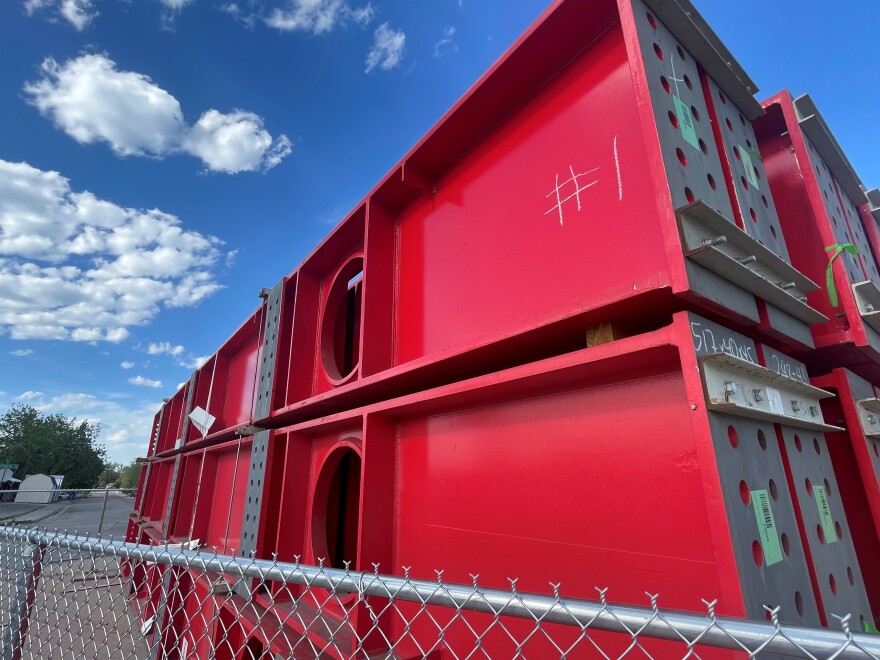Crews are outfitting massive underground caverns at the Sanford Underground Research Facility in the northern Black Hills to study neutrinos.
The Long Baseline Neutrino Facility has two caverns that are 500 feet long, 92 feet high and 65 feet wide. Those caverns will host cryostats filled with 17,000 tons of liquid argon to catch one of the universe’s fundamental particles.
SDPB’s Lee Strubinger spoke with Jaret Heise, the science director at SURF, who peers out at markers where utilities, like fire suppression and duct work, will get installed.
——————————————
JH: That's expected to continue for a little while yet, probably another year, year and a half.
At the early part of next year is when contractors associated with CERN will come on site to install and erect the large cryostats that are the coolers, the boxes that will contain the liquid argon in it. That that steel is now in Rapid City, 12 million pounds of steel for those two detectors, and trucks will start bringing that steel up early part of next year.
LS: So, there will be a lot of things happening all at once in terms of establishing the beams, putting in the utilities. It'll be really busy starting next year.
JH: Yeah, hopefully a large part of the utilities will be installed ahead of time. But yeah, next year the level of activity will will kick up at least one more notch.
LS: You said 12 million pounds of steel?

I think each cryostate is about 6 million pounds of steel. It's an amazing amount of steel. All of those steel beams will be slung underneath the cage. Those are the beams that will form the exoskeleton of the cryostats. And then, inside those cryostats will be the insulation—a meter of insulation for the membrane cryostat design. Inside that, will then be installed the detector components.
You an also sort of just make out on the floor some rectangles. That constitutes the outer perimeter of the cryostats. So, the beams will sit on those reinforced concrete pads. We'll see one at roughly the far extent of the detector from where we're standing right now. But, those pads are arranged around the entire perimeter of the cryostat rectangle footprint.
I went and looked at the beams. They're individually numbered for—and they already have like basically a placement. Like, how are those beams tailored to whatever specific spot?
A lot of the numbering, I suspect, is related to logistics. When the first truck shows up, which one goes on the first truck and which one goes on the second truck? So, it's what is the order for shipping from Rapid City to Surf?
So, they'll be brought into the cavern, staged at the end of the cavern closest to the Ross shaft, and then brought one by one as the cryostat is assembled on the on the east side of the cavern space. So, they're able to use half of the cavern space for lay down, but there's not an abundance of lay down space top or bottom.
And so, there's a lot of planning that's gone into the logistics and which beams go up to up to Lead at what point in time.
LS: I think 'A lot of planning' might be a little bit of an understatement.
I completely agree. People have been thinking about this for years. There's the warehouse in Rapid City. The shipment from Europe. All of that has to be choreographed very, very closely.
The rubber hits the road when trucks start showing up with steel and we don't have a place to put that steel except underground. There's a crew that receives it on the surface, a crew that transports it underground, a crew that brings it to the cavern, and then an assembly crew that starts erecting this giant Jenga cryostat with these massive steel beams.
What is theorized that we might be able to learn from particular experiments about neutrinos?
Creating a framework in which we understand why there's more matter in the universe and anti-matter requires several components.
One of those components is being tested with the DUNE physics program, testing interactions with neutrinos, changing the beam at Fermi Lab, shooting a beam of anti-neutrinos and comparing the signatures from those neutrino and anti-neutrino beams.
The Majorana Demonstrator is seeking to understand whether the neutrino is its own anti-particle and both of those elements are required for the theories on why we think the neutrino is responsible for creating that asymmetry in the universe.


